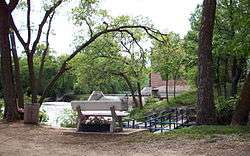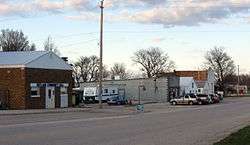Rutland, Iowa
| Rutland, Iowa | |
|---|---|
| City | |
|
Streetside in Rutland | |
 Location of Rutland, Iowa | |
| Coordinates: 42°45′32″N 94°17′34″W / 42.75889°N 94.29278°WCoordinates: 42°45′32″N 94°17′34″W / 42.75889°N 94.29278°W | |
| Country |
|
| State |
|
| County | Humboldt |
| Area[1] | |
| • Total | 0.90 sq mi (2.33 km2) |
| • Land | 0.90 sq mi (2.33 km2) |
| • Water | 0 sq mi (0 km2) |
| Elevation | 1,106 ft (337 m) |
| Population (2010)[2] | |
| • Total | 126 |
| • Estimate (2012[3]) | 127 |
| • Density | 140.0/sq mi (54.1/km2) |
| Time zone | Central (CST) (UTC-6) |
| • Summer (DST) | CDT (UTC-5) |
| ZIP code | 50582 |
| Area code(s) | 515 |
| FIPS code | 19-69375 |
| GNIS feature ID | 0460867 |
Rutland is a city in Humboldt County, Iowa, United States. The population was 126 at the 2010 census.
History
Rutland was platted in 1869.[4] It was named after Rutland, Vermont.[5]
Rutland was formerly serviced by Iowa Highway 367, which was decommissioned in 1980.[6]
Geography
Rutland is located at 42°45′32″N 94°17′34″W / 42.75889°N 94.29278°W (42.758785, -94.292847)[7] on the West Fork Des Moines River.
According to the United States Census Bureau, the city has a total area of 0.90 square miles (2.33 km2), all of it land.[1]
Demographics
| Historical populations | ||
|---|---|---|
| Year | Pop. | ±% |
| 1910 | 212 | — |
| 1920 | 197 | −7.1% |
| 1930 | 222 | +12.7% |
| 1940 | 255 | +14.9% |
| 1950 | 225 | −11.8% |
| 1960 | 221 | −1.8% |
| 1970 | 215 | −2.7% |
| 1980 | 163 | −24.2% |
| 1990 | 149 | −8.6% |
| 2000 | 145 | −2.7% |
| 2010 | 126 | −13.1% |
| 2014 | 127 | +0.8% |
| 2015 | 126 | −0.8% |
| Sources:[8][9] Source: | ||
2010 census
As of the census[2] of 2010, there were 126 people, 63 households, and 37 families residing in the city. The population density was 140.0 inhabitants per square mile (54.1/km2). There were 66 housing units at an average density of 73.3 per square mile (28.3/km2). The racial makeup of the city was 99.2% White and 0.8% from two or more races.
There were 63 households of which 15.9% had children under the age of 18 living with them, 47.6% were married couples living together, 6.3% had a female householder with no husband present, 4.8% had a male householder with no wife present, and 41.3% were non-families. 28.6% of all households were made up of individuals and 15.8% had someone living alone who was 65 years of age or older. The average household size was 2.00 and the average family size was 2.43.
The median age in the city was 49 years. 14.3% of residents were under the age of 18; 10.4% were between the ages of 18 and 24; 20.6% were from 25 to 44; 34.9% were from 45 to 64; and 19.8% were 65 years of age or older. The gender makeup of the city was 50.0% male and 50.0% female.
2000 census
As of the census[11] of 2000, there were 145 people, 64 households, and 40 families residing in the city. The population density was 161.3 inhabitants per square mile (62.3/km2). There were 69 housing units at an average density of 76.7 per square mile (29.6/km2). The racial makeup of the city was 97.24% White, 0.69% Native American, and 2.07% from two or more races.
There were 64 households out of which 29.7% had children under the age of 18 living with them, 53.1% were married couples living together, 6.3% had a female householder with no husband present, and 37.5% were non-families. 34.4% of all households were made up of individuals and 14.1% had someone living alone who was 65 years of age or older. The average household size was 2.27 and the average family size was 2.93.
In the city the population was spread out with 24.8% under the age of 18, 6.2% from 18 to 24, 23.4% from 25 to 44, 28.3% from 45 to 64, and 17.2% who were 65 years of age or older. The median age was 42 years. For every 100 females there were 116.4 males. For every 100 females age 18 and over, there were 98.2 males.
The median income for a household in the city was $30,556, and the median income for a family was $32,321. Males had a median income of $24,375 versus $15,500 for females. The per capita income for the city was $13,432. There were none of the families and 2.7% of the population living below the poverty line, including no under eighteens and 9.1% of those over 64.
Notable people

References
- 1 2 "US Gazetteer files 2010". United States Census Bureau. Retrieved 2012-05-11.
- 1 2 "American FactFinder". United States Census Bureau. Retrieved 2012-05-11.
- ↑ "Population Estimates". United States Census Bureau. Archived from the original on 2013-06-17. Retrieved 2013-05-23.
- ↑ History of Kossuth and Humboldt Counties, Iowa. Union Publishing Company. 1884. p. 866. Note that Google Books misspells "Humboldt".
- ↑ Chicago and North Western Railway Company (1908). A History of the Origin of the Place Names Connected with the Chicago & North Western and Chicago, St. Paul, Minneapolis & Omaha Railways. p. 120.
- ↑ Jason Hancock. "Highway 367". Iowa Highways. Retrieved February 8, 2010.
- ↑ "US Gazetteer files: 2010, 2000, and 1990". United States Census Bureau. 2011-02-12. Retrieved 2011-04-23.
- ↑ "American FactFinder". United States Census Bureau.
- ↑ Iowa Data Center
- ↑ "Census of Population and Housing". Census.gov. Archived from the original on May 11, 2015. Retrieved June 4, 2015.
- ↑ "American FactFinder". United States Census Bureau. Archived from the original on 2013-09-11. Retrieved 2008-01-31.
